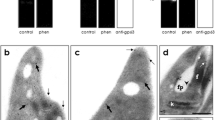Abstract
Drugs based on pentavalent antimony are first-line treatment of the parasite disease leishmaniasis. It is generally believed that Sb(V) acts as a prodrug, which is activated by reduction to Sb(III); however, the site of reduction is not known. It has been hypothesised that the reduction takes place in the parasites’ host cells, the macrophages. In this study, the human macrophage cell line Mono Mac 6 was exposed to Sb(V) in form of the drug sodium stibogluconate (Pentostam™). Cell extracts were analysed for Sb species by high-performance liquid chromatography with inductively coupled plasma-mass spectrometry detection. We found that Sb(V) is actually reduced to Sb(III) in the macrophages; up to 23% of the intracellular Sb was found as Sb(III). Transfer of the cells to Sb-free medium rapidly decreased their Sb(V) and Sb(III) content. Induction of the cell’s production of reactive oxygen species did not have any marked effect on the intracellular amounts of Sb(III).





Similar content being viewed by others
References
World Health Assembly. (2007) Control of leishmaniasis. Report A60/10
WHO (2006) Neglected tropical diseases, hidden successes, emerging opportunities. Report WHO/CDS/NTD/2006.2
Singh S (2006) New developments in diagnosis of leishmaniasis. Indian J Med Res 123:311–330
WHO (2009) Visceral leishmaniasis therapy: statement on the outcome of a meeting. Madrid
González U, Pinart M, Rengifo-Pardo M et al (2009) Interventions for American cutaneous and mucocutaneous leishmaniasis. Cochrane Database Syst Rev, issue 4
González U, Pinart M, Reveiz L et al (2008) Interventions for Old World cutaneous leishmaniasis. Cochrane Database Syst Rev, issue 2
Brahmachari UN, Chaudhury SC, Das J et al (1924) Chemotherapy of antimonial compounds in kala-azar infection. Part VIII. Quantitative studies in excretion of antimony (tartar emetic and urea stibamine). Indian J Med Res 11:829–838
Goodwin LG, Page JE (1943) A study of the excretion of organic antimonials using a polarographic procedure. Biochem J 37:198–209
Gourbal B, Sonuc N, Bhattacharjee H et al (2004) Drug uptake and modulation of drug resistance in Leishmania by an aquaglyceroporin. J Biol Chem 279:31010–31017
Maltezou HC (2010) Drug resistance in visceral leishmaniasis. J Biomed Biotechnol, article ID 617521
Roberts WL, Rainey PM (1993) Antileishmanial activity of sodium stibogluconate fractions. Antimicrob Agents Chemother 37:1842–1846
Sereno D, Cavaleyra M, Zemzoumi K et al (1998) Axenically grown amastigotes of Leishmania infantum used as an in vitro model to investigate the pentavalent antimony mode of action. Antimicrob Agents Chemother 42:3097–3102
Sereno D, Roy G, Lemesre JL et al (2001) DNA transformation of Leishmania infantum axenic amastigotes and their use in drug screening. Antimicrob Agents Chemother 45:1168–1173
Vermeersch M, Luz RId, Toté K et al (2009) In vitro susceptibilities of Leishmania donovani promastigote and amastigote stages to antileishmanial reference drugs: practical relevance of stage-specific differences. Antimicrob Agents Chemother 53:3855–3859
Callahan HL, Portal AC, Devereaux R et al (1997) An axenic amastigote system for drug screening. Antimicrob Agents Chemother 41:818–822
Ephros M, Bitnun A, Shaked P et al (1999) Stage-specific activity of pentavalent antimony against Leishmania donovani axenic amastigotes. Antimicrob Agents Chemother 43:278–282
Shaked-Mishan P, Ulrich N, Ephros M et al (2001) Novel intracellular SbV reducing activity correlates with antimony susceptibility in Leishmania donovani. J Biol Chem 276:3971–3976
Ephros M, Waldman E, Zilberstein D (1997) Pentostam induces resistance to antimony and the preservative chlorocresol in Leishmania donovani promastigotes and axenically grown amastigotes. Antimicrob Agents Chemother 41:1064–1068
Sudhandiran G, Shaha C (2003) Antimonial-induced increase in intracellular Ca2+ through non-selective cation channels in the host and the parasite is responsible for apoptosis of intracellular Leishmania donovani. J Biol Chem 278:25120–25132
Murray HW (2001) Clinical and experimental advances in treatment of visceral leishmaniasis. Antimicrob Agents Chemother 45:2185–2197
Hansen C, Schmidt B, Larsen EH et al (2011) Quantitative HPLC-ICP-MS analysis of antimony redox speciation in complex sample matrices: new insights into the Sb-chemistry causing poor chromatographic recoveries. Analyst 136:996–1002
Groemping Y, Rittinger K (2005) Activation and assembly of the NADPH oxidase: a structural perspective. Biochem J 386:401–416
Henson PM, Johnston RB Jr (1987) Tissue injury in inflammation. Oxidants, proteinases, and cationic proteins. J Clin Invest 79:669–674
Murphy K, Travers P, Walport M (2008) Innate immunity. Janeway's immunobiology, 7th edn. Garland Science, Taylor & Francis group, New York, pp 39–108
Ziegler-Heitbrock HW, Thiel E, Fütterer A et al (1988) Establishment of a human cell line (Mono Mac 6) with characteristics of mature monocytes. Int J Cancer 41:456–461
Chulay JD, Fleckenstein L, Smith DH (2001) Pharmacokinetics of antimony during treatment of visceral leishmaniasis with sodium stibogluconate or meglumine antimoniate. Trans R Soc Trop Med Hyg 82:69–72
Rees PH, Kager PA, Keating MI et al (1980) Renal clearance of pentavalent antimony (sodium stibogluconate). Lancet 316:226–229
Basu JM, Mookerjee A, Sen P et al (2006) Sodium antimony gluconate induces generation of reactive oxygen species and nitric oxide via phosphoinositide 3-kinase and mitogen-activated protein kinase activation in Leishmania donovani-infected macrophages. Antimicrob Agents Chemother 50:1788–1797
Lintschinger J, Koch I, Serves S et al (1997) Determination of antimony species with high-performance liquid chromatography using element specific detection. Fresenius J Anal Chem 359:484–491
Tonks A, Morris RHK, Price AJ et al (2001) Dipalmitoylphosphatidylcholine modulates inflammatory functions of monocytic cells independently of mitogen activated protein kinases. Clin Exp Immunol 124:86–94
Roberts WL, Berman JD, Rainey PM (1995) In vitro antileishmanial properties of tri- and pentavalent antimonial preparations. Antimicrob Agents Chemother 39:1234–1239
Author information
Authors and Affiliations
Corresponding author
Rights and permissions
About this article
Cite this article
Hansen, C., Hansen, E.W., Hansen, H.R. et al. Reduction of Sb(V) in a Human Macrophage Cell Line Measured by HPLC-ICP-MS. Biol Trace Elem Res 144, 234–243 (2011). https://doi.org/10.1007/s12011-011-9079-9
Received:
Accepted:
Published:
Issue Date:
DOI: https://doi.org/10.1007/s12011-011-9079-9




